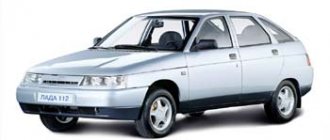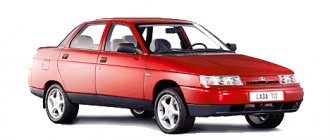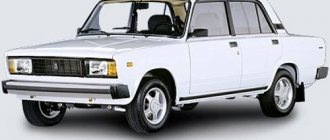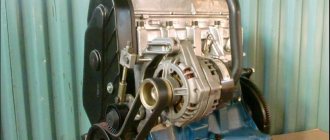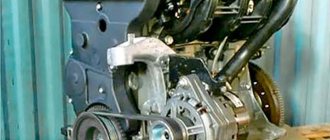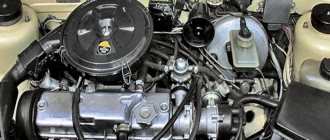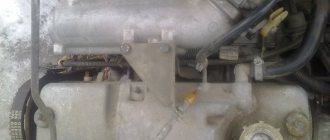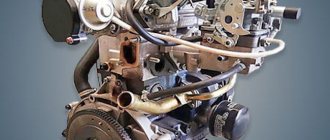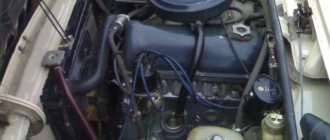The end of the 90s for the domestic automobile industry was marked by the appearance of the VAZ 2112 engine. It was a completely new power unit in its design, which included the use of 2 camshafts, as well as 16 valves (4 for each cylinder). The engine joins the tenth family of front-wheel drive cars.
It was introduced in 1997, and if you look at the facts, it turned out to be the manufacturers' first engine with 16 valves. Therefore, this particular engine is the ancestor of all subsequent versions with two camshafts. Thanks to this solution, manufacturers were able to increase performance and improve technical characteristics.
Characteristics
| engine's type | Petrol |
| Power | 92.5 l. With. |
| Torque | 128 Nm at 3700-3900 rpm |
| Volume | 1.5 l (1499 cc) |
| Design | in-line |
| Fuel type | petrol |
| timing belt | DOHC |
| Compression | 10.5 |
| Cylinder diameter | 82 |
| Piston stroke | 71 |
| Number of cylinders | 4 |
| Number of valves | 16 |
| Petrol | AI-95 |
| Cylinder operating order | 1-3-4-2 |
| Weight | 120 kg |
| Maximum speed | 175-185 km/h |
| Years of manufacture | 1998 — 2006 |
| Fuel supply | injection, distributed injection |
| Ignition system | coils/plugs |
| Cylinder numbering | from the crankshaft pulley |
| Cylinder head | Aluminium alloy |
| Cylinder block | cast iron 28 kg |
| Inlet | polymer manifold with receiver |
| Release | pipe with neutralizer |
| Camshafts | 2 |
| Ring material | steel, cast iron |
Graphs of 16 valve engines - power and torque
All engines of the “tenth hatchbacks” are ordered by power as follows: 21120, 21124, 21114 and 2111. They develop 93, 90, 81 and 77 “forces”. The graph shows how power varies with rpm.
The first two engines, 20 and 124, are 16-valve. Both belong to the Euro-3 class.
Engines 21124 of later years of production meet Euro-4 standards. They have an improved catalyst installed. The ECU unit was also installed differently, updated.
124 engine under the hood of the “two-wheeler”
The pistons of the 124 series engines have grooves for the valves. Simply put, the internal combustion engine of the VAZ-21120 is plug-in (valve bending as a result of a broken timing belt, the valves will need to be replaced, and then it depends), and 21124 is not plug-in (does not bend the valve). Let's estimate the torque.
The most interesting thing here is the VAZ-21120 engine. In terms of “low-end traction” it is not much inferior to 8-valve engines.
Formal characteristics
Here are the characteristics of two different motors:
- ICE model: 21120/21124;
- Working volume: 1,488/1,596 l;
- Compression ratio: 10.5/10.3;
- Power: 93/90 hp;
- Rated power speed: 5600/5000 rpm;
- Maximum torque: 140/131 N*m;
- Recommended fuel: AI-95/AI-95;
- Ecology: Euro-3/Euro-4 or Euro-3.
The lower the compression ratio, the more “omnivorous” the engine will be in relation to fuel.
Modifications
Let's consider models of internal combustion engines. First, the basic design of the VAZ 2112 15 16v engine was created. In this model, there is free space inside the block and cylinder head, which is a disadvantage, therefore, after the release of the first model of the 21120 engine, other improved modifications began to be produced. In model 21124, the engine was increased to 89 hp. and increasing the volume of the internal combustion engine to 1.6 liters.
In model 21126, the engine design was improved, as a result of which the engine acquired a volume of 1.6 liters, and the power indicator of the design was increased to 98 hp. Model 21128 has the largest combustion chamber volume, which is 1.8 liters. At the same time, the power characteristics of the engine of this car model were increased to 105 hp.
In these modifications, major repairs are carried out less frequently, and the valves do not bend. The first modification was made to increase engine capacity and achieve world quality standards. Changes in these modifications were made by increasing the block height to 197.1 mm and increasing the piston stroke.
In the next modification, engineers created the greatest resource for various system components. For this purpose, cylinder honing was used according to the Federal Mogul method. In design 21126, the number of sets of liners and pistons is reduced to 3 pieces. In this case, the step between them is 0.01 mm. Model 21128 is produced not by the AvtoVAZ production association, but by another manufacturer, Super-Avto CJSC.
ICE performance has been improved:
- engine capacity - 1.8 l;
- power characteristics increased to 75 kW;
- torque is 162 Nm.
The cylinders have a diameter of 82.5 mm; a new crankshaft was created that provides a piston stroke of 84 mm; The width of the rings is increased to 2 mm in oil scraper models. The throttle cross-section has increased and is 51 mm.
The new model has Siemens injectors installed, which have high performance. Model 21127 was released in 2013. In it, the torque is increased to 148 Nm, the volume is increased to 1.6 liters, and the power characteristic is 106 hp.
Model 21129 has a volume of 1.8 liters. It has a phase shifter installed. Various engine configurations have been created (LI, GLI, SLI), in which additional options can be installed, such as electric windows, door locks, and an immobilizer.
- Comparison of modifications
- cylinder head
Piston assembly
This part of the power unit is made of aluminum, the working skirt is longitudinally conical with an oval cross section. The pistons have four recesses for the valves, protecting them from bending. For each motor model, parts should be selected according to weight, not allowing each other to exceed more than five grams. The part is equipped with two upper compression rings and one oil scraper ring at the bottom.
The piston pins are made of steel and have a tubular cross-section. The elements are secured from falling out with a pair of retaining spring rings. They are divided into three groups based on diameter; the pin is marked on the bottom, and it must be of the same class as the piston.
Design Features
A new version of the VAZ 2112 engine with increased power was created by AvtoVAZ together with specialists from Porsche and General Motors.
Motor 2112 has the following design changes:
- a separate drive has been created for the exhaust tract; the intake valves are controlled by the cams of their intake pipe camshaft;
- steel connecting rods 121 mm long were created;
- holes were made in the instrument block for attachments;
- improved: distribution mechanism, cylinder block assembly, crankshaft, lubrication system, spark plugs, torque, maximum speed of the internal combustion engine;
- special hydraulic pushers were created that saved owners from periodically adjusting the valves and choosing their number;
- improved control of the operating temperature of the fuel in the internal combustion engine;
- a floating landing of the piston is performed;
- Oil channels are created inside the cylinder head.
HOW OFTEN SHOULD I CHANGE GDP?
According to the recommendations of Avto-VAZ, replacement of high-voltage wires of the VAZ 2114 should be done every 30 thousand kilometers. In practice, motorists rarely comply with these replacement deadlines, since if the wires do not have any mechanical damage, they can travel about 100-150 thousand km.
When the service life is exceeded, the internal resistance of the GDP increases, which negatively affects the transmission of the electrical impulse. This leads to problems with ignition and acceleration dynamics, since when the supply of current to the spark plugs is delayed, the normal engine operating cycle is disrupted.
Change the wires every 25-30 thousand km and everything will be fine
Source
Malfunctions and repairs
The new generation engine, subject to operating conditions, operates for quite a long time. The basic modification was created jointly with the German company Porsche, which is considered the most advanced in the creation of engines.
A small disadvantage is the use of a toothed belt drive, which requires the installation of high-quality spare parts, which cannot always be found in car repair shops.
At the same time, some motorists do not carry out regular maintenance in a timely manner, which leads to a reduction in the service life of the device.
Malfunctions that may occur in the operation of the internal combustion engine, and methods for eliminating them:
- Adjusts the engine. The fault lies in the cylinder head distribution unit, spark plugs or wires.
- The engine is idling unsteadily. In this case, you need to check the crankshaft sensor, throttle plate and control device. If this does not help, then the mass air flow sensor may have failed.
- At idle or when the vehicle is moving, the drive stalls. Such a problem may result from contamination of the throttle assembly, its sensor or IAC.
- If the engine does not catch when starting. If the battery and starter are working properly, then the problem has occurred in the power supply or ignition system.
- Hydraulic compensators are knocking. The breakdown consists of a decrease in oil pressure in the engine.
- The engine warms up slowly. You should check the presence of coolant, connecting rods and thermostat operation.
- The internal combustion engine does not pull well, operation is accompanied by vibration. In case of such a malfunction, it is necessary to diagnose the engine.
- Oil pressure is insufficient. There can be many reasons for this phenomenon. This can happen due to untimely replacement of lubricant in the motor. Over a long period of use, the oil pump may break down.
- If the indicator turns on, this indicates that there is no oil pressure. In this case, you need to stop to find out the reason. If necessary, call a tow truck.
Weak spots
Unfortunately, the VAZ-2112 is not without them. The most important one is the timing belt. If it breaks, a meeting with the valves is inevitable. And this is already a serious repair of the cylinder head. A pump leak can cause a breakdown, causing the belt to become splashed with coolant, become wet and lose its properties.
Leaking camshaft oil seals cause the belt to become oily, which is no less dangerous. Wearing the shafts also does not bring any benefit. The fact is that in this case the belt gets slightly distorted. Its presence is indicated by the appearance of a grinding noise when the engine is not warmed up.
Sometimes the motor starts to “trouble”. As a rule, the cause of this phenomenon must be sought in the electrics (ignition module, high-voltage wires, spark plugs) or in the throttle valve, idle air control. The culprit may be various sensors (DPKV, DPS, DMRV).
The thermostat does not shine with quality. As a result of its failure, the engine may overheat, or, conversely, the inability to reach operating temperature.
The car owner is often bothered by various unauthorized noises. They are worth paying close attention to. Knocks can be caused by faulty hydraulic compensators, connecting rod or main bearings.
If any malfunctions are detected, the best solution would be to go to a service station to diagnose the engine.
Service
When servicing an internal combustion engine, you need to know the brand of fuel, what kind of oil needs to be filled, and how much oil is needed for a given design. You also need to know the service life of your car’s engine and the presence of a timing belt.
Change engine oil in 2 ways:
- With engine flush. In this case, after draining the liquid, you need to add flushing liquid or the oil that will be filled into the engine. Then turn on the engine. It should run for 10 minutes. Then drain the oil.
- No engine flushing. After the old oil is drained, new oil is immediately poured in.
Let's look at the procedure for changing the oil. For this you will need:
- capacity 4 l;
- key to 17;
- oil filter remover.
Place the car on the inspection hole. Remove the cap from the oil filler neck. This will make it easier for the fluid to drain out because there is no vacuum forming at the top of the engine. Then remove the oil pan plug.
Drain the oil. Do not allow hot liquid to come into contact with the skin. The draining continues for 10 minutes. When changing the oil in engine 21124 to another brand of oil, the engine must be flushed.
For this purpose, fill in the flushing liquid to the bottom mark of the dipstick. Turn on the engine. It operates at idle speed for 10 minutes. Drain the liquid.
When replacing the lubricant, the filter must also be replaced. Unscrew the oil filter head cover using a screwdriver or a puller. Before installing a new filter, fill it halfway with oil and lubricate the O-ring, which will prevent air locks.
Screw the drain plug onto the crankcase. Then they install the oil filter. After this, the volume of lubricant is monitored using a dipstick. To prevent oil overflow, it must be poured slowly and the level must be monitored. Then tighten the plug and return the dipstick to its place. Turn on the motor. When the oil pressure warning light goes out, the engine will stop. Check the oil level. If necessary, it needs to be topped up.
Maintenance
The ergonomic design of the internal combustion engine allows you to service the 2112 engine with the following frequency:
| Maintenance object | Time, year or mileage, 10,000 km (whichever comes first) |
| Timing belt | replacement after 100,000 km |
| Battery | 1/20000 km |
| Valve clearance | 2 /20000 km |
| Crankcase ventilation | 2 /20000 km |
| Belts that drive attachments | 2 /20000 km |
| Fuel line and tank cap | 2 /40000 km |
| Motor oil | 1/10000 km |
| Oil filter | 1/10000 km |
| Air filter | 1 – 2/40000 km |
| Fuel filter | 4 /20000 km |
| Heating/Cooling Fittings and Hoses | 2 /40000 |
| Coolant | 2 /20000 km |
| Oxygen sensor | 1.5/100000 km |
| Spark plug | 1 – 2 /20000 km |
| Exhaust manifold | 2/40000 km |
Unlike coolant, oil partially settles on the walls of the lubrication channels, so with a volume of 3.5 liters, 3.2 liters of a semi-synthetic product is actually required.
Tuning
Before starting tuning, you need to take into account the design features of the 2112 engine. One of the frequently used tuning options is boring the cylinders for piston 21128 by 5 mm. Chipping is not used. You can replace the throttle with 54-56 mm. The exhaust tract with a 4/2/1 “spider” is being installed. You can install STI-2, STI-3.1 or Stolnikov camshaft.
If piston chip tuning and crankshaft modification are performed, which increase the piston stroke, then the valves must be replaced together. ICE 2112 is considered the 5th generation of engines with a 4-stroke cycle. In the initial version, the design was not fully developed, as the valves bend. In later models this defect was corrected.
If you change the cylinder head and install a wide-phase camshaft, the power characteristic will be 130-140 hp. If you install a crankshaft with a long crank measuring 37.8 mm, then modification of the combustion chamber and the use of T-shaped valves will increase the power characteristics to 150 hp. Some car enthusiasts, in order to increase power, mount ICE 2112 on rear-wheel drive VAZ 2105-2107 cars. To install the engine under the hood, car owners cut off part of the partition of the internal combustion engine compartment.
Conversion of an 8-valve engine to a 16-valve engine
This alteration is carried out by modifying the bolts securing the head. To upgrade, you need to change the head. In order for each screw to fit into the hole in the head, it must be adjusted in length and diameter. The holes in the gasket also need to be modified.
Then they change the pistons, connecting rods and adjust the wires. It is necessary to take into account the difference between sixteen-valve pistons and 8-valve pistons. The placement of the sensors is also excellent. Leave the ignition system and connect the unit using high-voltage wires.
Increase in engine displacement
The working volume of the internal combustion engine depends on the piston diameter and stroke. In the factory version, the displacement is increased by installing a higher block and a crankshaft with a crank radius that will increase the piston stroke to 75.6 mm. The displacement can be increased to 1580 cm³ by installing a crankshaft with a crank radius increased by 1.9 mm, which will provide a piston stroke of 74.8 mm.
Spider exhaust manifold
To install the “spider” manifold, the exhaust system unit is dismantled: the intake pipe, the exhaust manifold of the internal combustion engine. Instead of a standard exhaust manifold, a “spider” is installed. It must fit precisely onto the cylinder block and not touch the wiring.
Installing a zero resistance filter
A zero-resistance filter is installed in the engine instead of a standard air filter. It allows you to reduce inlet resistance without reducing filtering capacity. Thus, it increases the power characteristics of the motor. Thanks to the installation of a zero filter, you will not have to change the filter device every 10,000 km. The zero filter can be washed with a special composition, this will restore its functions. After installing it, the engine torque increases.
You can do the installation yourself. First, remove the standard filter housing. Then the selected design of a zero-resistance cone filter is installed on the pipe that fits the air flow sensor. The filter brand must be selected according to the diameter of the installation site.
Engine VAZ 11183
This is the youngest engine in the Lada engine line. It is practically not used in the Volzhsky plant’s own products at this point in time, with the exception of the remnants of old versions of the “Standard” configuration, but it still finds application in the products produced by the plant under the Datsun brand.
This engine is a logical continuation of the VAZ 21114 engine, which was previously used on the Samara-2 and VAZ 2110 families. The main difference from its predecessor was the increase in the compression ratio in the cylinder to approximately 9.6 units, this was achieved by changing the combustion chamber, which made it possible to lower the maximum torque bar torque from 3000 rpm to 2600, the peak value is 120N/m. Maximum power is achieved at rpm of 5200 and is a low 81 horsepower. The material of the cylinder block, like all other products of the VAZ engine division, is cast iron, which significantly increases its service life and subsequent maintainability. The regulated engine life is 150 thousand kilometers, but in practice, engines with a similar index often last more than 300 thousand with proper care and operation.
- Easy to repair and maintain;
- Due to the low compression ratio, it is possible to use cheaper fuel with an octane number of 92 units;
- In the event of a timing belt break or a cooling system pump stop, the valve group does not meet the piston group, which greatly simplifies subsequent repairs and financial costs
- Not a high transport tax, not crossing the 100 horsepower bar.
- Due to the use of an old type piston group, the engine is quite noisy and vibration-loaded;
- There are no hydraulic compensators, which requires adjustment of the valve group every 15 thousand kilometers;
- There is no automatic timing roller tensioner; periodic tightening is required to eliminate the problem of the belt slipping over the rollers.
Other differences
The engines also differ in their “inhalation” design. The 120th intake consists of two aluminum parts: a manifold (“horn”) and a receiver, connected to each other by rubber corrugations. Unit 21124 is “decorated” by an intake system made of plastic and consisting of a single part.
The ignition system is designed differently. The VAZ 2112 is equipped with an ignition distributor module, and on the 21124, individual coils are installed for each cylinder. Due to differences in intake and ignition systems, valve covers also differ.
The 1.6-liter unit has some other differences from its brother: the pressure regulator has been moved from the fuel rail to the pump, the catalyst is located directly at the cylinder head, there are 2 oxygen sensors (Euro-3) instead of one (Euro-2) for the 1.5 liter. The split timing case design makes it easy to replace the timing belt.
People often ask: where is the serial number of the engine on the VAZ 2112? Indeed, the number located under the air filter is quite difficult to detect. It is located at the rear end of the BC, under the thermostat housing. To find the required numbers, you need to release the air filter mount and tilt it slightly to the side.
If corrosion makes it difficult to read the serial designation, you should use fine abrasive sandpaper and then wash the area with WD-40.
What cars was it used in?
Only three VAZ models using the 2112 engine left the assembly line of the manufacturer's plant:
- 21103 – sedan;
- 21113 – station wagon;
- 2112 – sedan, GLI luxury and Standard versions.
Since the characteristics of the engine 21124 and internal combustion engine 21128 are not too different from the original, it was mounted on the same VAZ Lada. The modification of the 21126 engine was equipped exclusively with Prioras.
To take or not to take
The VAZ-2112 has more disadvantages than advantages, so its purchase is rather a necessary measure. You can buy it as your first car: you don’t mind breaking it, it’s inexpensive to maintain, you won’t go broke on fuel, but if you have complaints about comfort, it’s better to save up and get a more or less complete foreign car.
If you are not bothered by the lack of basic safety systems and comfort options, pay attention to more “fresh” options. At least it has power steering and air conditioning, and such a car will last longer than the old “two-wheelers”.
Author: Igor Vasiliev
What was your first car? Would you buy yourself a used two-wheeler? Tell us about it in the comments.
Impact of body geometry on handling
During the operation of a VAZ 2112 car, at some point deformation of body parts occurs. Safety on the road and ease of operation depend on the level of their wear.
VAZ 2112 has been produced since 1999. The car body of this model is similar to the 2110 modification, the difference is that the first one is slightly shorter than the second one.
The geometric properties of the 2112 made it possible to equip the car with many additional functional capabilities.
It combines the winning parts appropriate for the “ten”, as well as the rear seat of the station wagon from the 2111 model, which made the car much roomier and more maneuverable. The ability to transform the rear seat allows, if necessary, to significantly increase the volume of the interior. Improved maneuverability properties have simplified the process of entering a turn, which has significantly increased the level of safety for road users.
The VAZ 2112 has several modifications, for example, model 21123 is characterized by an unusual design of the hood and bumper, which allowed the car body to become popular among many car enthusiasts. After some time, the VAZ 2112 had a new grille model, and the hood took on a standard look.
Power core
The VAZ 2112 engine was not created from scratch. Its design with a 16-valve gas distribution mechanism (GRM) repeats the model 2110, and the cylinder block (BC) is a copy of the “eight” (21083). This can be verified by comparing their geometric parameters: bore diameter and center distances.
True, the blocks are not interchangeable, since they differ in the diameter of the cylinder head (cylinder head) mounting screws. Unlike parts 21083 and 2110, the BC has additional oil channels in the main bearings to supply oil to the lubricating nozzles. Through these devices, additional lubrication of the lower part of the cylinder surfaces is carried out, as well as cooling of the piston bottoms.
Now a little about how the 120th and 124th engines differ from each other. VAZ 21120 contains BC 2112 with a height of 194.8 mm, and 21124 contains BC 11193. The height parameter of the latter is 197.1 mm (the so-called “high” block). The 124th crankshaft has a longer stroke compared to the 12th. For motor 2112, the elbow has a size of 35.5 mm (stroke 71), and for motor 21124 it has a size of 37.8 mm (stroke 75.6). As a result, the working volume of the 124th version is 1.6 liters, versus 1.5 for the 120th.
The pistons also differ from each other. Both have counterbores to ensure the exit of the valve plate. However, on the 120 engine their depth is deceptive. It is designed only for the normal functioning of the timing belt, and in the event of a toothed belt break, the “meeting” of the valves with the pistons becomes inevitable. The 124th drive has everything in order; eliminating the incident will only require replacing the belt without disassembling the power unit.
Replacing the pistons on the 21120 engine with 124s will allow you to avoid the troubles associated with a broken belt. True, the power of the VAZ 2112 engine will be somewhat less.
